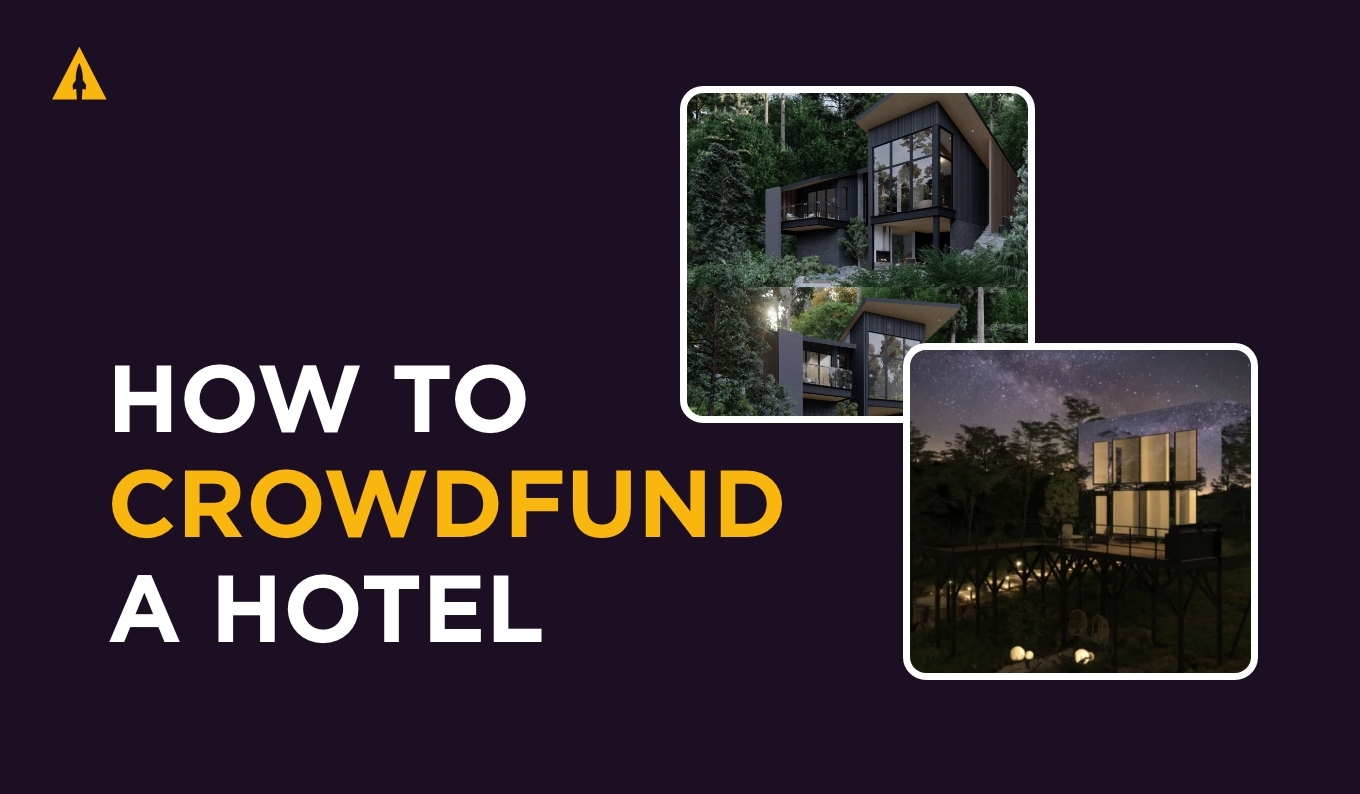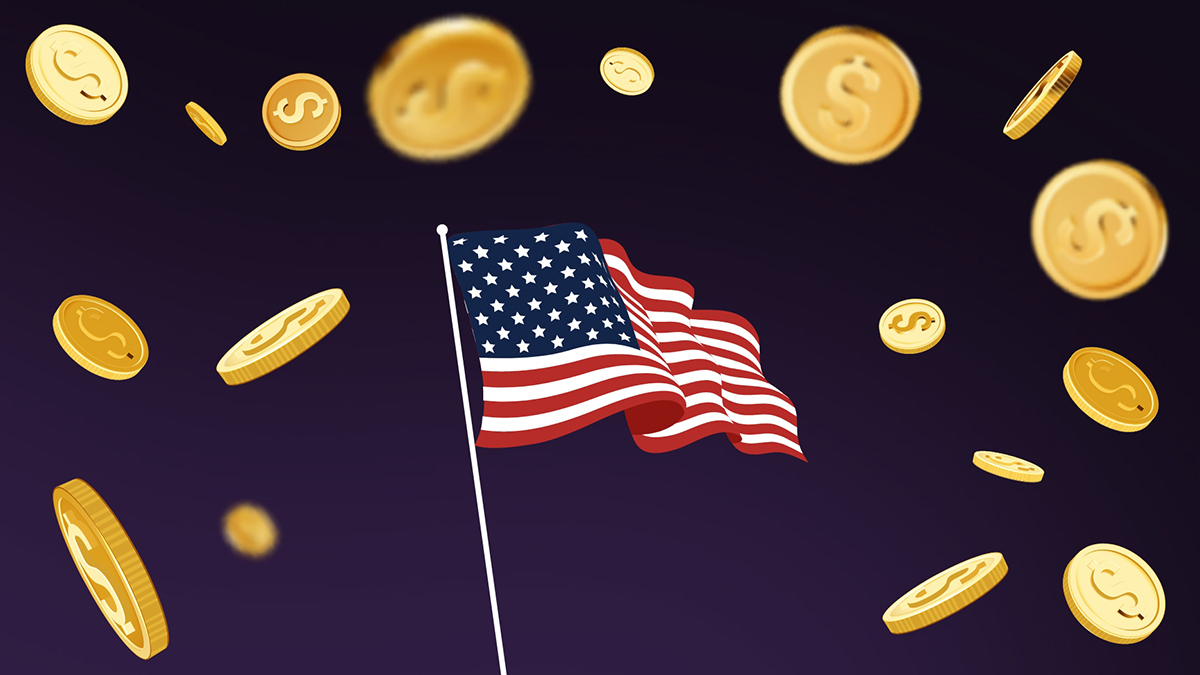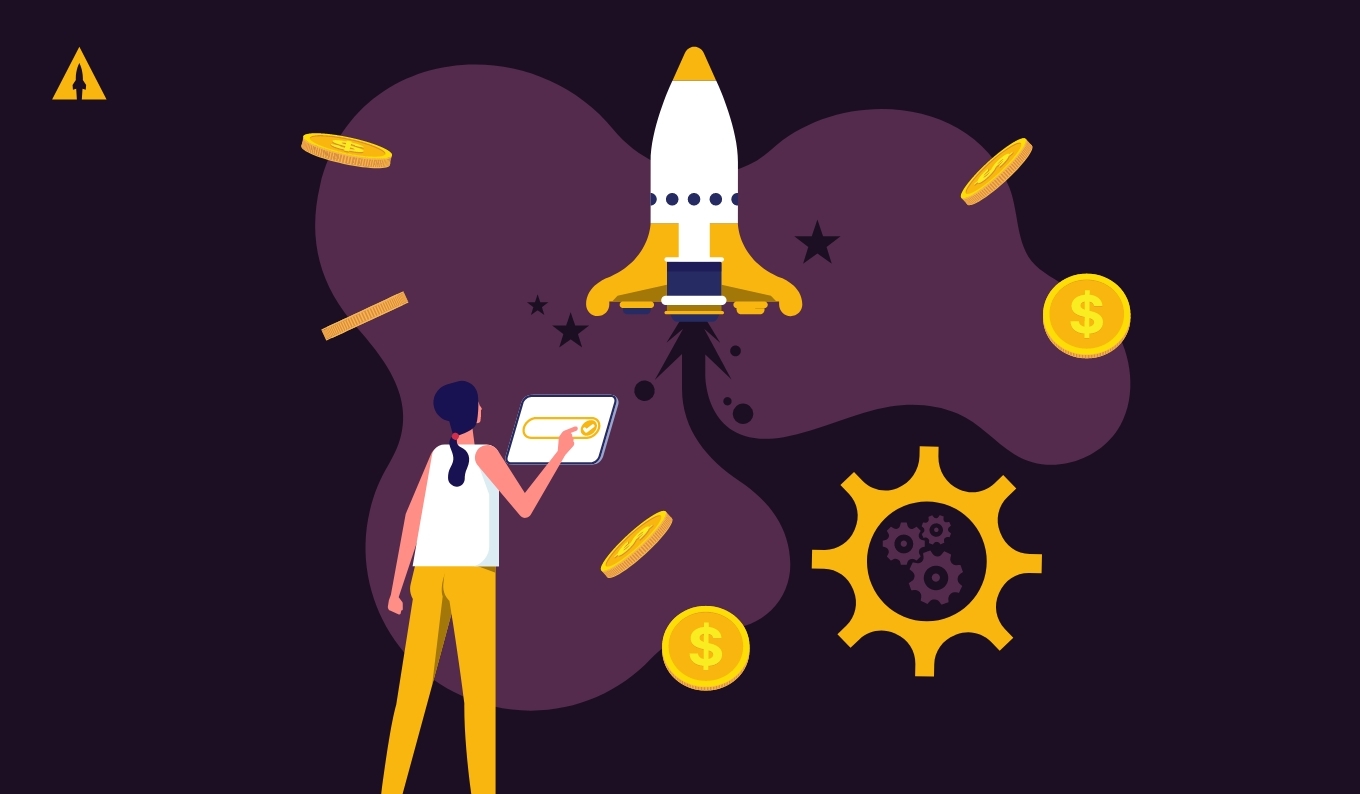
Probably like you, I seem to spend hours of my day talking about tariffs. The time not spent talking about them, I’m researching them. The time not spent researching them, I’m still just thinking about them.
So many questions are swirling around in my head, but the one I’ve been asking myself the most is “should creators even be launching right now?”
This past week I dove into the data and spent a lot of time reflecting to make up my mind. I’ve concluded that most products should not delay their crowdfunding campaign launch because of the US tariffs.
Let’s dive into why.
Contents
Reason 1: You won’t ship for a really long time
“I’m putting my launch on hold. I want things to settle a bit.”
I’ve heard a variation of those two sentences many times over the last 2 weeks. And I understand the thought process. But the thing is… if you start working on your launch today, you likely will not ship your product for 6 to 12 months from now.
That’s a lot of time for “things to settle a bit.”
As I’ve already said in my Kickstarter guide to US tariffs, I highly recommend you do not increase your retail price because of tariffs. Because tariffs are a tax and should be treated as such. Taxes & shipping costs should be charged (1) separately from your retail price and (2) right before you ship your product.
If you aren’t shipping for 6 to 12 months from today, then you have a long time before you might (emphasis on might) have to charge extra for tariffs in the pledge manager. And if it does get to the point where you have to charge a fee, Kickstarter, BackerKit, and Gamefound all seem to be making tools to make collecting tariffs easier.
This doesn’t have to be a surprise or something you spring on your backers later. Tell them on your campaign page that you might charge a tariff fee to US backers only. Let them know that it wouldn’t be charged until right before you ship. Give them a range of what those tariff costs may be and also let them know that if tariffs fall below a certain percentage, you won’t charge a tariff fee. What that percentage is will depend on what your target gross margins are. I talk about how to figure out your target gross margins in my guide on tariffs that I’ll link again here.
Of course, I can’t guarantee that tariffs will go down. But I can guarantee that crowdfunding will (1) buy you a lot of time for tariffs to come down and (2) generate cash flow for you now.
Worst case scenario, you charge the increased tariff fee to your backers, which isn’t ideal, but you won’t have to worry about massive tariff fees sinking your business.
Reason 2: Advertising costs are going down
First-time creators are not the only ones being spooked by tariffs.
Many established companies and corporations are scrambling to figure out what to do and are going into “risk-management mode.” Translation: they’re cutting budgets.
You can see a survey done by IAB, a leading voice in the marketing industry, that shows most marketers are expecting ad spend budgets to be cut because of tariffs.
“Nearly all U.S. advertisers (94%) are worried about the impact of tariffs on ad spending, according to an IAB survey. Of those, 57% are ‘extremely concerned’ and 37% are ‘somewhat concerned.’ The majority of those surveyed (60%) expect ad budgets will drop by 6%–10%. Nearly a quarter (22%) expect an 11%–20% drop. Budget contractions are anticipated to peak mid-year, with 45% of advertisers planning to reduce overall ad spend.”
But why is this a good thing for you?
The cost of advertising is fundamentally driven by supply and demand.
Starting with supply, there’s a limited number of people to target with ads. When there’s a lot of demand to reach those people – i.e. a lot of companies competing & spending money on advertising – the cost goes up.
On the other hand, if ad budgets get cut, the demand side of the equation will be changed and the cost of advertising will go down.
We’re already seeing this across our campaigns.
We track the daily CPM (cost per 1,000 impressions) across all our projects. After looking at data from 336 unique projects, the CPM in April is currently 30.77% lower than March, where March’s average CPM was $23.20 and April 1st to the 14th was $16.06.
You can see how CPMs changed per day if we look back over the last 30 days:
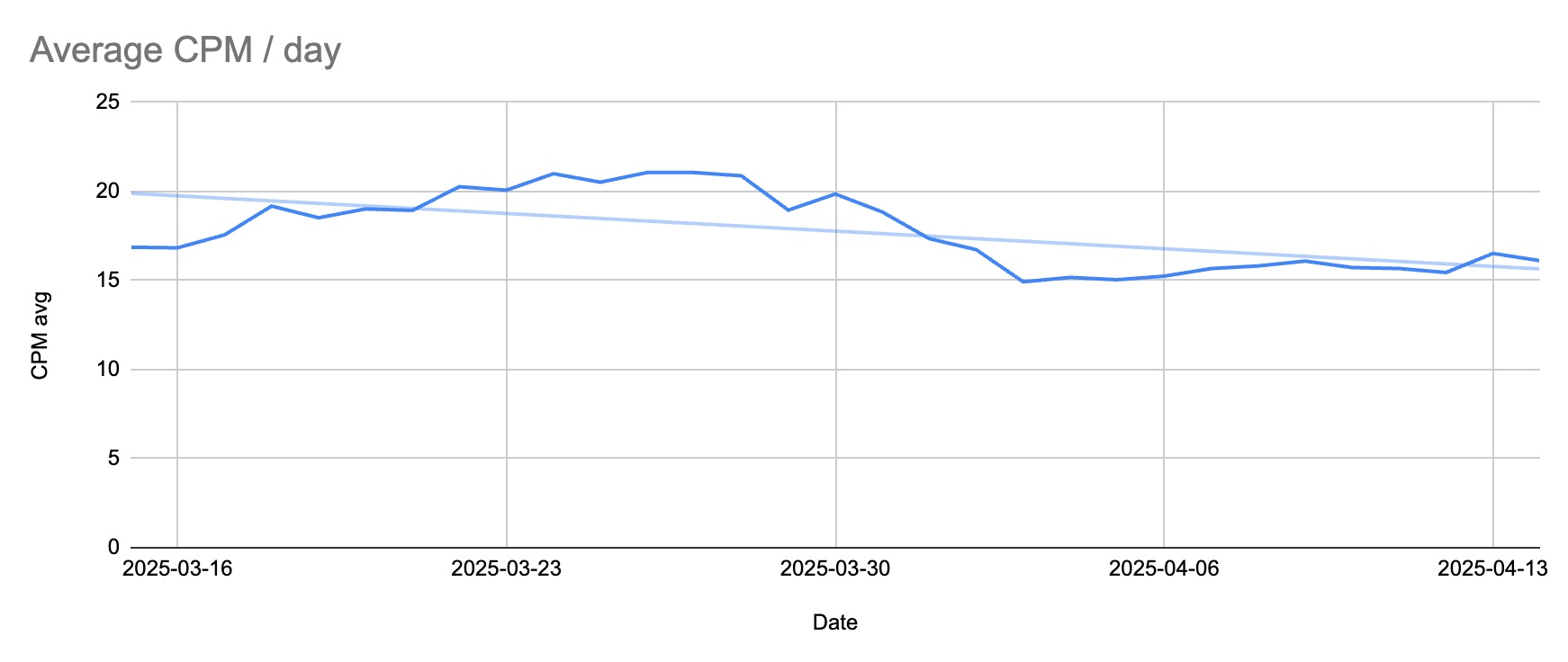
With ads being one of the biggest costs for most creators, lower ad costs will have a big impact on your profitability.
Reason 3: Freight costs are already at 12 month lows
The average cost of a 40 ft container worldwide is down over 50% from its peak the last 12 months.
Just check out this graph from the Drewry World Container Index.

Just like advertising, the cost of freight goes up when there’s more demand. As there will be less companies shipping their products from China, the cost of freight will likely stay low or maybe even go lower.
Lower freight costs will help offset some of the possible increased costs caused by tariffs.
Reason 4: Backers are still backing campaigns
All this doesn’t really matter if backers aren’t backing campaigns. But the data says otherwise.
I spoke with Sean Leow (COO of Kickstarter), Alex Gair (Senior Sales Manager at BackerKit) and Konstantinos Manos (owner of TabletopAnalytics.com).
I asked them all the same question: Are backers still backing campaigns on Kickstarter & BackerKit? Has there been any notable decrease in conversion rate?
Sean said, “We are closely monitoring the data and not seeing any significant changes in backer behavior in terms of cancellations or willingness to back projects across the board in 2025.”
Alex said, “So far we don’t see any significant changes — backers are still backing and we’ve seen no increases in cancelations in pledges.”
And Konstantinos said, “Between Kickstarter & Gamefound, I’m not seeing any notable dip in conversion rate on projects yet.”
So for now, it looks like backer conversion rates haven’t been negatively affected in any noticeable way. And this doesn’t surprise me too much. We already have a good example of what backers do when they’re charged a tax post-campaign.
Remember that most backers outside the US already pay extra fees with VAT and still buy crowdfunding products. The fee they pay with VAT isn’t small either. It’s charged on the sale price, meaning it will likely be much higher than any US tariff that’s charged on the cost of production.
Reason 5: Kickstarter reaches a global market
There’s no denying that the US market is incredibly important, but it’s not the whole market. A large percentage of the total funding on Kickstarter campaigns come from outside the US.
For example, on UNA, a tech product currently live on Kickstarter, the distribution looks like this:
- 546 backers from the USA
- 1,165 backers total
- 53.13% of backers are from outside the USA
And on Sea Beasts, a board game that launched on Kickstarter, the distribution looks like this:
- 3,317 backers from the USA
- 5,414 backers total
- 38.7% of backers are from outside the USA
You can verify this for yourself by looking at any campaign on Kickstarter. Just click on the “community” tab on a creator’s campaign page and you’ll see where backers are coming from. It looks something like this:
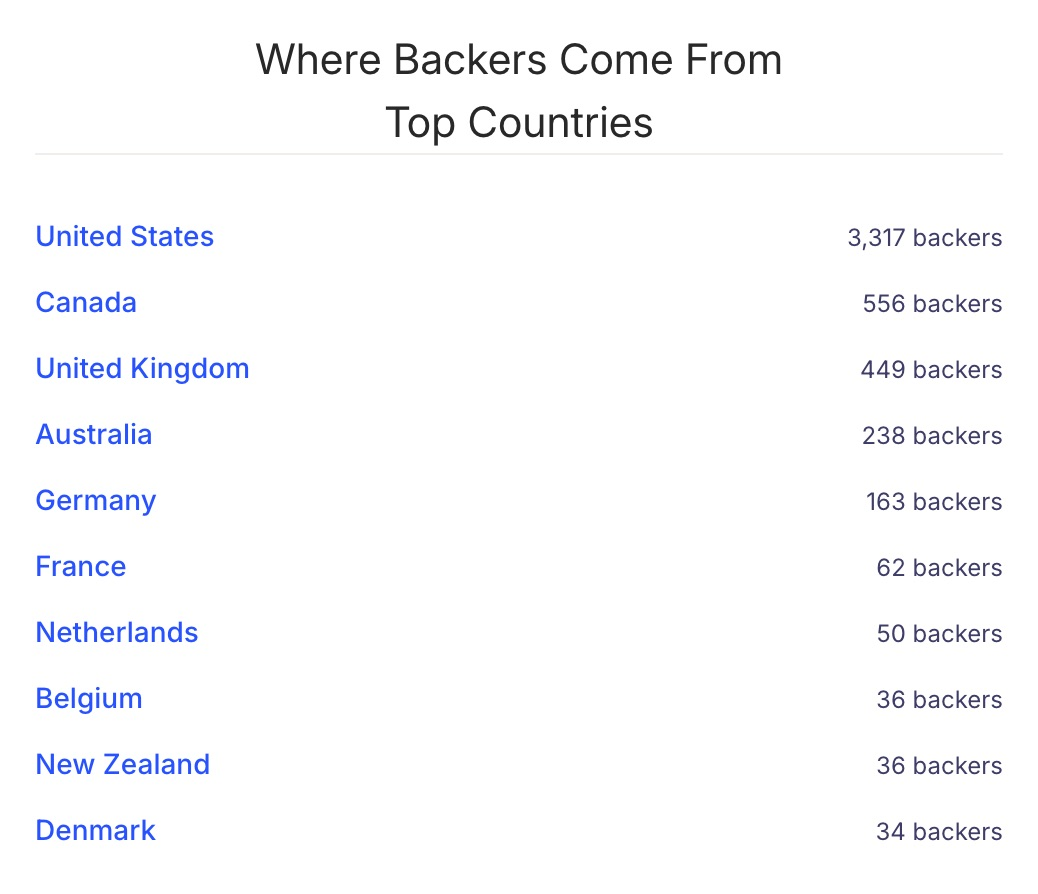
Moral of the story: you should be able to avoid US tariffs for backers outside the US by shipping your product to fulfillment hubs not based in the US. For most creators international backers will make up 30-50% of all their backers.
Keep this in mind when you are doing your numbers. You may decide that you are willing to eat some of the decreased margin in the US because the margin is higher in other parts of the world.
It may be riskier to delay your launch
Maybe you’re thinking “Mark, these numbers are great and all, but I think this will all blow over soon.” Because of that, you want to wait just a little bit longer before you launch. But how much longer? Two weeks? One month? One year?
I don’t know when the tariffs will change. But what I do know is that no one knows. And when no one knows, all you can do is try your best to decrease risk by following the facts:
- You won’t ship for a really long time
- Advertising costs are going down
- Freight costs are already at 12 month lows
- Backers are still backing campaigns
- Kickstarter reaches a global market
These 5 reasons decrease risk more than putting a project on hold. If you want to launch your product, this may be the best time to start. Talk to us here if you want some help.

